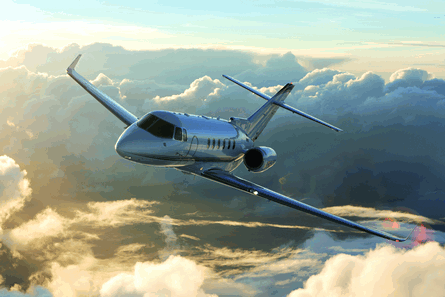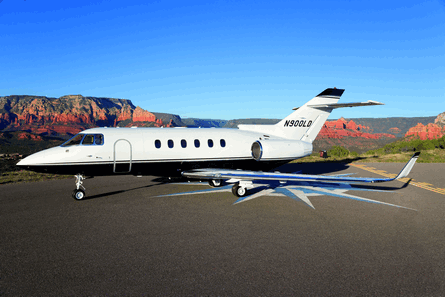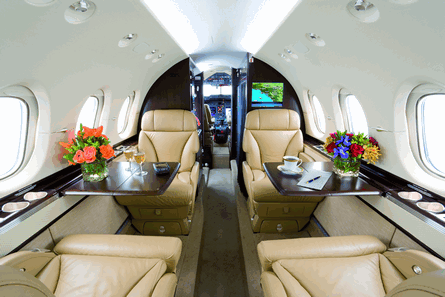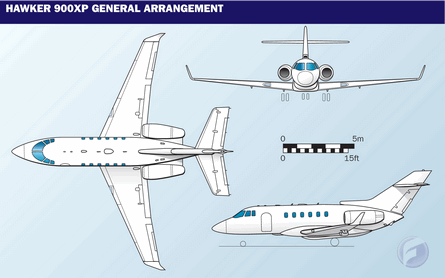While it may be an exaggeration to say there should be a picture of a Hawker 900XP in the dictionary under the definition of "mid-size business jet," it would not be much of one. The 900XP's roots can be traced back to the de Havilland DH125, first flown in 1962. Under the Hawker Siddeley and BAe banners, the 125 evolved into the BAe 125 Series 800. This was first flown in 1983 and incorporated many improvements over the original DH125: a longer fuselage that had debuted on the 600, new engines, a larger wing and an electronic flight system-equipped cockpit.
 |
|---|
© Hawker Beechcraft |
Before the type was sold to Raytheon, 700 of the several 125 variants had been produced in the UK, making it the most prolific of all UK jet aircraft. With the purchase, Raytheon moved Hawker production to Kansas in 1996, but wing and fuselage fabrication remained and continues to this day in the UK. The first significant upgrade to the 800 under Raytheon was the launch of the 800XP in 1995, which featured 4,650lb-thrust (20.7kN) Honeywell TFE731-5BR engines. A Collins ProLine 21 integrated avionics suite was added in 2002. Production winglets graced the venerable Hawker in 2006. It is now dubbed the 850XP.
Certificated by the US Federal Aviation Administration in August last year and by the European Aviation Safety Agency in December, the 900XP represents the most capable and modern Hawker 125 model to date. The 900XP shares the same large mid-size cabin for which the Hawker is renowned, the largest cross-section in its class according to Hawker Beechcraft, owner of the Hawker range since March last year.
From the flightdeck divider to the aft pressure bulkhead the passenger compartment is 6.5m (21ft) long and 1.83m wide at its widest point. Headroom throughout the cabin is 1.75m, when measured from the aisle floor. The standard interior seats eight in a club forward arrangement with a three-seat divan and single seat aft. An optional six-place configuration is available, with more luggage space and a single seat replacing the standard configuration's divan. Both interiors have a lavatory aft, which is "belted" for seating during take-off and landing.
Flat Out Better
Since the laws of aerodynamics are unchanged, a number of "new and improved" business jet offerings are upgrades of current products. Avionics, aerodynamic tweaks and engines are three areas where recent advancements can breathe new life into a proven design. Previous owner Raytheon had made improvements in all three areas. On a "standard day", the Hawker could hold its own against its mid-size competitors, but under hot and high conditions its relative performance suffered.
The 900XP is the result of replacing the 850XP's TFE731-5BR engines with TFE731-50Rs. Both the -5BR and the newer -50R are rated at 4,660lb of thrust, but the -50R has a thermodynamic limit of 5,000lb, while the -5BR's is 4,660lb. The increased temperature margin offered by the -50R allows it to maintain rated thrust as conditions degrade from standard. At 5,000ft pressure altitude and ISA +20oC conditions, the -50R's 3,970lb of thrust is a 4.5% improvement over the 5BR's 3,800lb. In addition to higher thrust, the -50R offers reduced thrust specific fuel consumption, the result of over 70 design and material enhancements implemented by Honeywell. For a 1,100km (600nm) stage length, Hawker Beechcraft says there is a 4% reduction in fuel burn, and improved temperature margins have increased inspection and overhaul intervals by nearly 50%. These improvements are not without cost the newer, more-powerful and fuel-efficient engine is 20.4kg (45lb) heavier than its predecessor.
 |
|---|
© Hawker Beechcraft |
The Hawker 850XP has always been a load-and-go aircraft and the 900XP upgrade follows this rule. While its basic operating weight has increased by 41kg from the 850XP's, maximum take-off weight has not changed. Even with this minor reduction, eight passengers and their baggage can still be loaded with full fuel tanks. Reduced fuel consumption of the new engines give the 900XP greater range than the 850XP with comparable payloads. The published range advantage varies, depending upon selected cruise speed, with the relative advantage greater at high-speed cruise. With six passengers (a 545kg payload), Hawker lists an NBAA instrument flight rules range of 3,715km, a 315km improvement over the 850XP.
At long-range cruise speed, range increases to 4,485km, an advantage of 305km. These additional kilometres will give the 900XP true transcontinental legs, making Teterboro to San Francisco against 99% winds achievable. From London City airport on a 30oC (86°F) day, St. Johns and Goose Bay in Canada can be reached with six passengers, assuming 85% headwinds and ISA cruise conditions. Westbound transatlantic flights in the 900XP can bypass Iceland en route to North America.
On a standard day, the 900XP has a 7% shorter take-off field length than the 850XP. Both aircraft weigh the same and have engines that produce the same amount of thrust, but a change in bookkeeping gives the 900XP the advantage. When the 850XP was certificated, no credit was taken for runway performance improvements generated by the addition of winglets. When the 900XP was certificated, runway performance numbers were re-evaluated to capture the winglet's benefits. The news gets better for shorter runways as temperature and altitude increase. Hawker Beechcraft says that on a 20oC day taking off from the 2,135m runway at Aspen, Colorado - which is 7,280ft above mean sea level - the 900XP has nearly a 907kg greater useful load than the 850XP.
The extra hot and high payload capability generates real-world benefits. Assuming a nominal 1,980m-long runway at 5,000ft MSL on a 20oC day, at high-speed cruise the 900XP can carry six passengers 4,095km, 1,130km further than the 850XP. At long-range cruise speed the range increases to 5,095km, 1,630km better than the 850XP. Even on a 28oC day and assuming 85% winds, Aspen to Miami is well within reach for six passengers on board a 900XP.
Veteran Performer
Flight International was able to put the latest model of the Hawker through its paces over the skies of southern California. The test aircraft was US registration number N900LD, a customer aircraft on loan for the evaluation. Senior sales demonstration pilot Orlando Linares acted as pilot in command. Dennis Hildreth, senior product manager, rode in the cabin to answer programme and technical questions.
The Hawker silhouette is a familiar one, with its strong looking cruciform empennage. The wings are of conventional construction and are swept 20 degrees, as measured at 25% chord. Composite winglets that are 76cm tall have a supercritical aerofoil and add 1m to the wingspan. Laser-drilled leading-edge pieces had an unusual shimmer to them in the bright sunlight. Wing and tailplane leading edge anti-icing is provided by TKS fluid that weeps through the perforated surface. A 38 litre (10USgal) reservoir of TKS fluid allows for 108min of flight in icing conditions. Engine inlet cowls are anti-iced with bleed air.
Before accomplishing the pre-flight walkaround inspection, Linares started the Honeywell 36-150 auxiliary power unit to cool the cabin. Entry to the cabin is via a large counterbalanced door that incorporates four steps. A handy storage bin is in the door steps for gear pins and other "remove before flight" items. The APU control panel is to the left of the flightdeck entry doorway, allowing APU start without entering the cockpit. APU noise was fairly low, allowing unstrained conversation in all locations around the aircraft except near the tail.
The sizable conventionally activated control surfaces stood out during the inspection, as did the large flaps. A pair of hydraulically actuated airbrakes, one on top and one on the bottom, are on each wing. The 900XP carries the bulk of its fuel in two wing tanks, but also has an auxiliary ventral fuel tank able to hold 680kg in the rear of the fuselage. The Hawker is operated in and out of some austere fields, and overwing refuelling may be the only way to get fuel. Notably, all three tanks can be gravity fuelled, a handy feature if long distances need be covered from the outback.
Leaded Glass
The 900XP's flightdeck is an amalgam of old and new. Around the periphery are subtle reminders that this is a legacy design, albeit a very capable one. The small overhead panel contains controls for aircraft systems, all logically arranged. Large rocker switches on the overhead are effective, but whisper "1970s". Full-face emergency oxygen masks are stored uncovered outboard of each pilot seat - functional, not fashionable.
 |
|---|
© Hawker Beechcraft |
The centre pedestal and throttle quadrant host "manly" sized levers, wheels and stopcocks, all extremely functional. With the exception of the master warning system light panel, the forward instrument and glareshield panels shout "21st century". The Rockwell Collins ProLine 21 panel has four 8 x 10in (200 x 255mm) active matrix LCD displays arranged two per side in a portrait format. Each pilot has their own primary flight display and multifunction display.
Engine information can be displayed on any of the four large displays, but a conventional caution and warning lights panel has been retained. Automatic flight guidance system controls are well placed on a glareshield panel.
Standard on the 900XP are all the usual bells and whistles: dual attitude-heading reference system, traffic alert and collision avoidance system, enhanced ground proximity warning system, weather radar and dual GPS. A standard single file server unit provides an electronic charts capability with ownship position. Purchase of a second unit gives a chartless cockpit capability. ACARS datalink and ground-based graphical weather services from XM and Universal Weather are options.
After Linares had loaded the flightplan route into the flight management computer and straightforward pre-start flows were accomplished, the engines were started by their respective starter-generators. The engines were spun by battery power, the APU providing bleed air to cool the cabin and cockpit. The 900XP can be dispatched with an inoperative APU without operational restriction, with battery power sufficient to launch from austere fields. With flaps set to the take-off setting of 15 degrees and parking brake released, idle power alone started the Hawker rolling. Hydraulically actuated nose wheel steering is controlled by a handwheel on the left-hand side-wall. Up to 45 degrees of steering is available, allowing for tight turns on the congested ramp. The handwheel lacks a centreing feature, and initially I had difficulty determining the commanded steering angle. With practice, however, I was able to closely follow taxiway centrelines.
Some Bias is Good
Lined up on Orange County's Runway 19R, I set take-off power (96% N1) and released the toe brakes. Lacking any nose-wheel steering control from the rudder pedals, I kept my left hand on the handwheel while Linares held the yoke forward during the take-off roll. Acceleration for the lightly loaded 9,790kg aircraft (one passenger and 2,290kg of fuel) was brisk. At 80kt (150km/h), I took the yoke and Linares called "rotate" at 113kt. Yoke forces were light and a 15 degrees pitch angle was required to capture and hold V2 speed, 126kt.
As the landing gear was retracting during climb-out, Linares rapidly retarded the right engine to idle power. As on the Beechcraft Premier I that I had flown several years ago, the 900XP has a rudder bias system designed to counteract adverse yawing moments caused by an engine failure. While the much more expensive fly-by-wire Boeing 777 has a computer-operated thrust asymmetry compensation system designed to do the same thing, the 900XP's is ingenious in its simplicity. Bleed air from each engine is ported to two air struts attached to the rudder torque tube. Balanced engine power provides equal bleed air pressure, and no resultant rudder displacement. Should an engine fail, the resultant bleed air pressure differential moves the rudder to counteract the asymmetric thrust.
On my take-off the only pilot action required to safely fly the aircraft out of danger was to raise the right wing about 5 degrees, both feet flat on the floor. At my request, Linares then turned the bias system off, and over 60kg of force was required on the left rudder pedal to maintain co-ordinated flight. While pilots are trained to deal with engine failures during critical phases of flight, automatic systems that reduce pilot workload during an emergency need not be a luxury, as shown by the 900XP.
On the test flight, the ground run was less than 1,000m, lending credence to Hawker Beechcraft's listed take-off distance of 1,515m for a fully loaded aircraft. The 900XP's required take-off distance is slightly shorter than for one of its closest rivals, the Gulfstream G150's 1,525m, but longer than the Cessna Citation Sovereign's 1,090m. In general, take-off distance is a function of thrust to weight ratio and wing loading. The 900XP and G150 are closely matched in both parameters and resultant take-off performance is similar.
Once the engine failure exercise was complete and flaps retracted, a 250kt climb was started. Climb power was set by advancing the throttles until "climb" was shown on the electronic information system. N1 displays when it reached 100%. Like the G150 and the Sovereign, the 900XP lacks an auto-throttle system. The Sovereign, however, has a climb power detent on the throttle quadrant, a feature I preferred over the 900XP's mechanisation. Passing 10,000ft, I reduced the pitch attitude to capture and hold a speed of 270kt, which was held until M0.68 was intercepted at around FL270.
Textbook Climb
During the climb numerous air traffic control vectors and hold-downs were given, but less than 26min after brake release the aircraft reached the final cruise altitude of FL390. At MTOW for a textbook climb, Hawker Beechcraft says that a total of 444kg of fuel will be burned in the 25min needed to reach 41,000ft while travelling 217km downrange. For the same conditions, a G150 requires the same time to reach 41,000ft, travels the same distance and burns 460kg of fuel, just 17kg more than the Hawker. The more powerful and lightly wing-loaded Sovereign needs just 18min to reach 41,000ft, travels downrange 171km and burns only 408kg of fuel.
With the autopilot engaged and 100% N1 set, the Hawker accelerated to and held a thrust limited speed of 246kt, just under MMO of M0.80. Total fuel flow was 760kh/h (1,680lb/h) as we clipped along at a true airspeed of 446kt. At a more sedate long-range cruise speed of M0.70, a total fuel flow of 525kg/h pushed us along at 391kt. Test day temperature was hotter than standard, yet my cruise performance figures were nearly identical to the published data. Based on that data, one can rest assured the 900XP will meet its cruise performance claims. In terms of cruise speed the 900XP slots in neatly between the G150 and Sovereign.
In absolute terms, the Sovereign can go further than either the G150 or 900XP, but at a markedly slower pace. The G150 and 900XP offer nearly identical range capabilities, but if one prefers speed the G150 has the edge.
Large Mid-Size Cabin
The Hawker literally defined the mid-sized cabin, and the 900XP did not disappoint. At cruise altitude I left the flightdeck to sample the large cabin. I found the test aircraft's standard eight-passenger interior was finished to a high standard. At high-speed cruise the cabin deck angle is nearly level, and only slightly nose-up at long-range cruise speed. Ambient noise level was low, allowing conversation at normal voice levels. Two 15in LCD screens are mounted in the cabin, one on the forward divider and the other on the aft. The Collins airshow and audio-video entertainment system are controlled via 3.8in LCD sidewall-mounted controllers. Additionally, a remote control is provided. One unique entertainment feature offered to passengers is a glareshield-mounted cockpit camera. Looking forward through the windscreen, the camera allows passengers to see in real time what the pilots are seeing.
 |
|---|
© Hawker Beechcraft |
Of the three mid-size jets listed, the one with the most cabin volume felt the most cramped when I flew in it. While offering 17.6m3 (620ft3) of cabin volume and the longest length (7.37m) of the three, the Sovereign has the smallest diameter cross-section. Compared with the Hawker, the Sovereign feels like the business jet equivalent of the Boeing 757. The Hawker has a wider cross-section that makes it feel markedly larger than the Sovereign. At 6.5m long it offers an expanded forward galley and plenty of room for eight seats. The G150's nearly rectangular cross-section evokes an airy feel and seems to provide a less "enclosed" space. Seating for eight is available, but due to its shorter cabin (5.38m), it is less spacious than the Hawker.
Straight Stalls
After returning to the flight deck, a descent at 3,000ft/min (15.3m/s) was initiated to try the Hawker at its MMO of M0.80. A series of small sharp control inputs in each axis showed the aircraft to have good damping at its limiting Mach. Slowing the aircraft down to 300kt, a series of rolls revealed heavy aileron forces, yet pitch and roll forces were well harmonised. Overall, the aircraft was quite stable in pitch and roll. Passing FL310 at 260kt, well below VMO of 315kt, full deployment of the airbrakes caused a slight nose pitch-up that took less than 3kg of force to counter act. The Hawker's large airbrakes and their small pitching moment should be a great aid if an emergency descent is required.
I had been impressed with the 900XP's docile handling qualities during the simulated engine failure, and set up for two approaches to stall to see if its low-speed flying qualities were similarly as benign. At 14,000ft and a gross weight of 9,060kg, I slowed the aircraft using its large airbrakes to 150kt, where I retracted them. A series of bank-to-bank rolls at 150kt, with the yaw damper off, showed the 900XP to have a crisp roll response and I found the ailerons and rudder to be well co-ordinated.
With idle power set, I further slowed the clean aircraft at about 1kt/2s, while maintaining level flight. In a 14 degrees nose-up attitude at 110kt, the stick shaker went off. A slight relaxation of aft yoke pressure and rapid advance of the power allowed the Hawker to fly out of the approach to stall with minimal altitude loss. At speeds above 110kt, the Hawker responded well to small control inputs, and it displayed no tendency to drop a wing at the shaker speed. Landing gear and flaps were extended to 45 degrees for a landing configuration approach to stall. Deceleration rate was just over 1kt/s in idle power. In a 14 dergee nose-up attitude the stick shaker activated at 99kt. Again, the aircraft displayed no tendency to roll off. Normal flight was regained by dropping the nose to 7 degrees nose-up and adding power, accelerating the aircraft in level flight. Had I ignored the stick shaker, a hydraulically powered stick pusher would have forced the nose down to break the stall.
Manual Approach
Return to Orange County was via vectors to an instrument landing system approach to Runway 19R. I coupled the autopilot and let it fly the aircraft. The heading select lateral mode of the autopilot accurately tracked heading, while the vertical speed pitch mode allowed for smooth descents.
When the ILS approach was selected in the flight management computer, the localiser frequency was auto-tuned, a nice feature. On a dog-leg to final, I disengaged the autopilot and hand flew the approach. I closely followed the flight display's guidance, which smoothly directed localiser capture. Pitch force changes with gear and flap extension, before glideslope capture, were small and easily trimmed out. On final approach, roughly 85% N1 was needed to hold a target speed of 126kt. The Hawker felt solid on final, and fine control inputs required to track localiser course and glidepath were easily effected.
When Linares called "minimums" at 200ft above the ground, I advanced the power and initiated a go-around. The flaps were immediately retracted to 15 degrees and gear retracted once a climb was established. A visual circuit was flown at 3,000ft above sea level, with the turn to final dictated by the need to fit in the arrival sequence of airliner traffic. In the traffic pattern I found the field of view out the cockpit to be good, aiding in finding the numerous aircraft pointed out by ATC and the on-board TCAS display. As at altitude, I again found the Hawker's manually operated flight controls allowed smooth, predictable and precise manoeuvring.
Lift Dump
Gear and flaps were extended to 45 degrees for the full stop landing. On final I followed the visual glide path provided by the visual approach slope indicator. At 3°, the visual approach has the same descent angle as the ILS, but it intercepts the runway closer to the approach end than does the ILS. The responsive digitally controlled engines allowed me to accurately track the target speed of 126kt. The flare manoeuvre was started at about 10-15ft, with pitch attitude increased from 1 degree to 4 degrees nose-up. Touchdown was on centreline around 430m from the approach end.
Immediately after touching down I moved the airbrake selector to the "lift dump" position. On landing, with flaps selected to 45 degrees, the airbrake lever opens the airbrakes and commands the flaps to further extend to 75 degrees, markedly increasing aerodynamic drag. Moderate toe braking and less than maximum thrust reverse on both engines quickly slowed the Hawker to a safe taxi speed with a ground roll of less than 900m. Taxi back to the chocks and post flight flows were uneventful, with operational procedures similar to those of other business jets.
All Rounder
The mid-size business jet segment is quite crowded, and I have flown three of the prominent players: Cessna Citation Sovereign, Gulfstream G150 and the Hawker 900XP. All three can take six passengers on a transcontinental journey in comfort, yet each brings something different to the table. The Sovereign has the best field performance and longest legs, but at the slowest cruise speed. The G150 has the most up-to-date cockpit with PlaneView-like features and a large oval cabin cross-section. The 900XP offers a larger cabin cross-section than the Sovereign, with a longer cabin than the G150. In terms of speed and range the 900XP is markedly better than its 850XP predecessor, yet the G150 still holds the edge over the 900XP. On balance the 900XP is a rugged and very capable machine. It is not the fastest nor the least expensive, but it just might be ideal for those seeking an all around mid-size business jet.
 |
|---|
Source: Flight International























